The Mysterious Desert Towers of Uzbekistan’s Lost Civilization
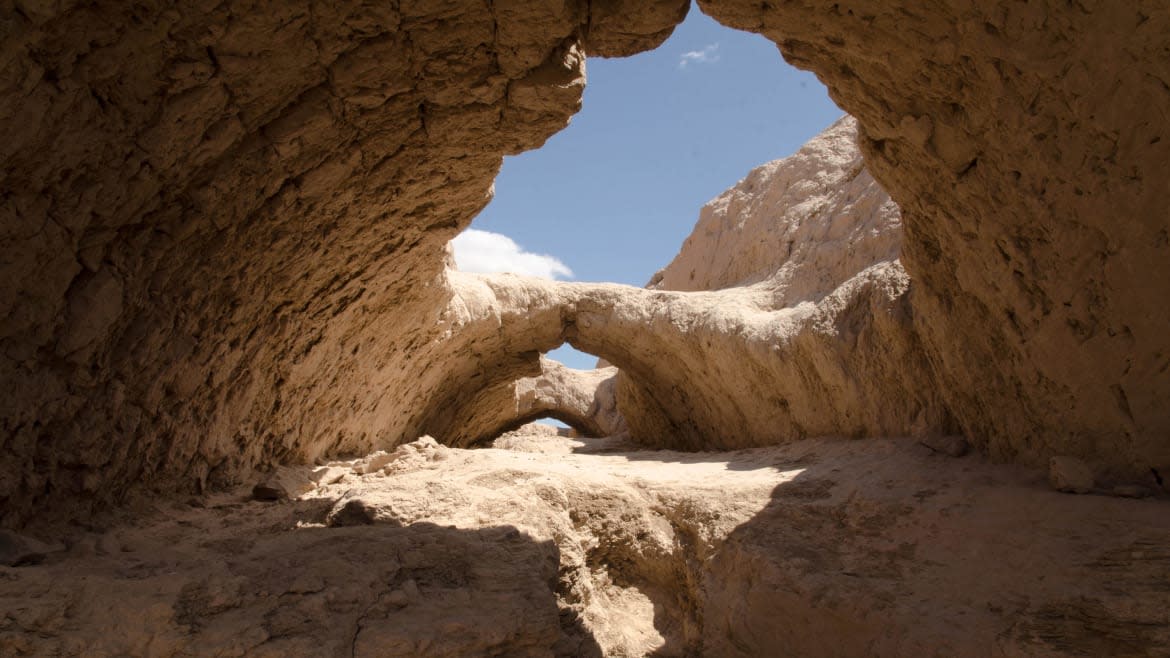
We drove out of Khiva on a bright and blistering summer morning. The shared taxi passed over the Amu Darya River, pulsing with Himalayan snow melt, and drove on past rich, irrigated fields and away from the massive domed mosques and medieval tile work of Uzbekistan’s Silk Road cities. We were headed into the former-Soviet Central Asian country’s arid northwestern frontier.
Our little band of backpackers was searching for something to excite our domed-out senses. When we hit the panoramic desert, the horizon flattened. Slowly, the three austere mountain fortresses of Ayaz Kala rose from the badlands in the distance, wild protrusions from history’s depths. They’d been abandoned in the seventh century A.D. after more than a millennium of sporadic inhabitation.
In the roughly 1,200 years before their rediscovery by Soviet archaeologists, they’d towered above a people forsaken by the erratic, ever-shifting waters of the Amu Darya. These and other kalas, desert fortresses dotted across the northwest of Uzbekistan, are the last remnants of Khorezm, an ancient civilization that flourished for a millennium in the Amu Darya’s delta, between the sands of the Kyzyl Kum and Kara Kum. This was the deep history we’d missed in the medieval cities, clues left by a mysterious civilization most of us had never heard of. And the fortresses at Ayaz Kala are the most extreme example, the most remote and rugged structures built by the Khorezmians. In winter, they are covered in ice and snow, battered by cold desert winds. In summer, temperatures reach into the high nineties. The winds blow on, and the fortresses stand still.
Ayaz Kala 1, the high fortress, is an astonishing unmediated portal to a primeval world, an unrestored acropolis. Climbing up the epic outcrop it’s built on, I felt like I was stepping back to the fourth century B.C., when these walls were erected, and almost expected to see ancient Khorezmians toiling within. When I entered through the mud gate, all I saw was a flat seven-acre expanse, which seems to be all there’s ever been. There’s no evidence that there were ever permanent dwellings here. The oldest theories suggest that the fortress housed a military garrison, living in tents or reed huts, passing through, like us. Corridors, known as archers’ galleries, run along the outer walls.
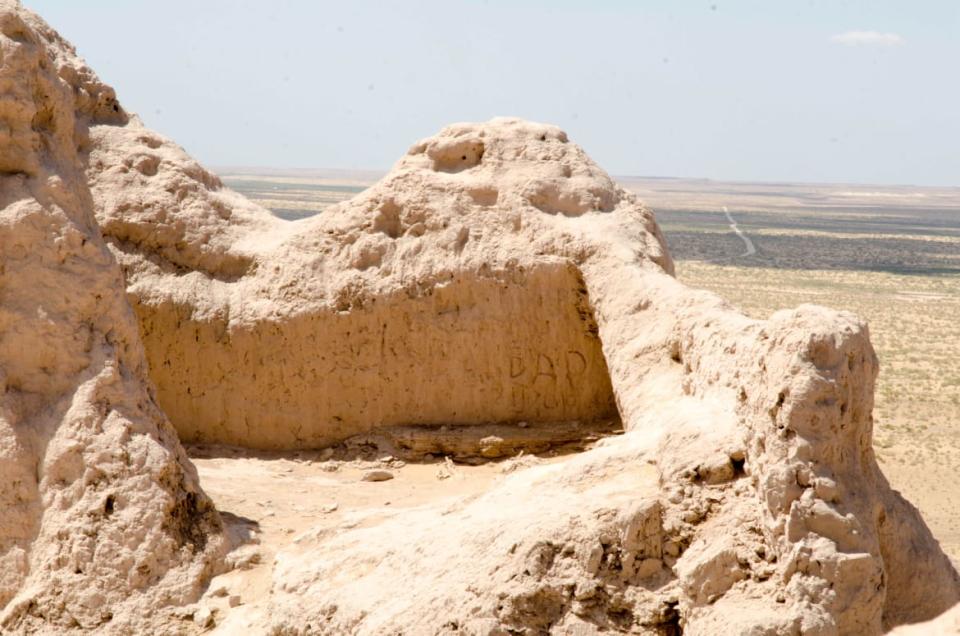
Time has melted them slightly, dripping minor mud stalactites over the gridwork, but I still got lost staring at the outlines of the mud bricks and the flat bits of straw sticking out. More recent theories about the uses of this fortress argue that these corridors are the only parts of the fortress where humans would have lived. They picture families herding their cattle into the central clearing and gathering within the walls to survive the terrible winters. Gazing into the galleries, I could see how someone could have called them home long ago. Over the edge, we saw Ayaz Kala 2, looking lonely and inaccessible on a lower hill, the last of the major structures built here. On the dusty plain below, lay Ayaz Kala 3, “the palace,” and clusters of ancient farmsteads, now mostly melted into mounds of clay, scattered around the dry canal that once gave this settlement life.
At the tail end of the 20th century, only the most intrepid tourists made it out to Ayaz Kala. It was after the turn of the millennium, when a maverick businesswoman set up yurts behind the fortress and started offering lodging, that traffic picked up. In 2008, World Monuments Fund noted that “in recent years Ayaz Kala has become a tourist attraction, but few measures have been put in place to protect the structures from visitors.” Uzbekistan was hard to visit then, the tourist flow was relatively limited. But following the death of autocrat Islam Karimov in 2016, the borders, for many, have opened. Starting in 2019, passport holders of more than two dozen countries, including most of Europe, could enter Uzbekistan visa-free. In 2020, they expanded the visa-free regime to include 22 new countries, including China. Americans are still not part of that system, but we can enter with an easy $20 e-visa. Before COVID-19 cratered tourism globally, the upshot of these changes was clear. Tourists flooded in—nearly 7 million in 2019, 26 percent more than the previous year. The heavily restored historical cities of Samarkand, Bukhara, and Khiva—with their luxury hotels and golf carts whizzing around the medieval sites—were Disneyland-crowded. In the high season, even the rustic yurt camp was seeing more visitors. When the pandemic is a mere memory, it’s likely that even more tourists will come.
The effects of this flood were already visible last year. Watching a tourist kick a foothold into a wall that’s stood for millennia, I couldn’t help but realize that however imposing the exterior of the fortress, it is also extremely fragile. There are bits of graffiti and erasing them would be fairly straightforward, but as the number of visitors increases, so does the number of footholds kicked into the walls and messages engraved in the mud brick. Ayaz Kala has survived two millennia of changing water levels, ambitious construction projects, and pummeling winds. Can it survive its current occupation? Or will the fortresses fall, like the other Khorezmian sites that have been lost since the Soviets first studied them more than 80 years ago?
The Soviet archaeologists came with pith helmets and safari jackets. They recited Kipling over campfires in the night and sang songs composed over their six decades together in the desert. They let Soviet history pass them by as they explored the remains of Khorezm, digging from 1937, when the show trials made Moscow and Leningrad so unsafe that academics fled to the desert, until 1997, six years after the Soviet Union fell. Ranging over hundreds of thousands of square miles, they catalogued at least a thousand sites, excavated more than a hundred, and published upwards of 900 articles and books. “It is probably no exaggeration to say that the Khorezmian Archaeological-Ethnographic Expedition,” wrote Irina Arzhantseva, keeper of the expedition leader’s archive and a participant in the final phase, “has no equal in archaeological fieldwork the world over.”
In the late ‘40s, they started flying biplanes over the monuments, aware that they were photographing a place that would be irrevocably altered by Soviet modernization. Their expedition was funded by a devil’s bargain. In 1934, the Soviet government had decreed that any development project which threatened a culturally significant site would fund the study of that site. Khorezm sat in the unforgiving path of progress.
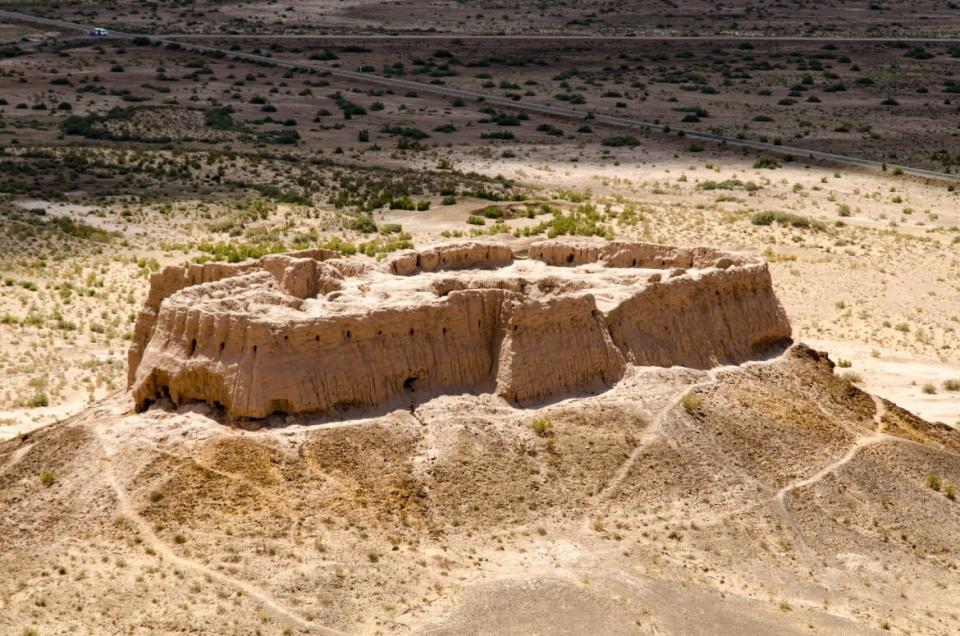
Since the 1860s, when American cotton exports declined during the Civil War and the Tsar ordered the conversion of Uzbekistan into a cotton field, Russians had tried to wring abundance out of this land. The Soviets took this to a new extreme. Uzbekistan was to produce cotton for the whole Soviet Union, but growing that much cotton required a new and massively robust irrigation system. Engineers and manual laborers built canals and hydroelectric power stations. They tried to divert Siberian rivers. By the final years of the Soviet Union, the result of these massive projects was clear: a more radical desiccation than this arid region had ever known. It led to the near total disappearance of the Aral Sea, once the world’s fourth largest lake. But the archaeologists could not foresee these traumas. Their concern was the immediate impact of the canals and the rising waters on their objects of study.
So they surveyed the ancient landscape, trying to imagine the lives of ancient Khorezm. The classic accounts were of limited use. The Khorezmians emerge for one mysterious moment in early history. The emissary of the Khorezm’s king rides out across Uzbekistan with 1,500 horsemen. They ride into Afghanistan, where Alexander the Great is holed up for the winter. The king offers Alexander the services of his army and they come to a peace agreement. The impression is of a wild nomadic kingdom, overflowing with warriors on horseback, seeking a quiet truce. The Soviet interpretation clashed with this vision. They saw the Khorezmians as a settled agrarian people under one ruler, reasoning that to build the complex network of canals and imposing fortresses some measure of central control was necessary. It’s possible the massive projects of the Soviet state which threatened to pave over Khorezmian history dominated their imaginations, but it’s also possible that they were right. The oasis may have been a tantalizing echo of Mesopotamia, or Eden.
In the West, a younger generation has questioned that Soviet orthodoxy. They agree that there was agriculture here, but they say it wasn’t the only way these people operated. “The more recent interpretations are much more focused on this flexible agropastoralism,” says Elizabeth Baker Brite, an archaeologist and professor at Purdue University. But their theories, too, may be shaped by their circumstances. They are a mobile generation, young Americans, Australians, Italians, working in a place that would have been largely inaccessible to their parents. Maybe the Khorezmians were nomads too, often on the move, but always at home. Wherever was good for the cattle, wherever the vineyards would bloom, that’s where they would be.
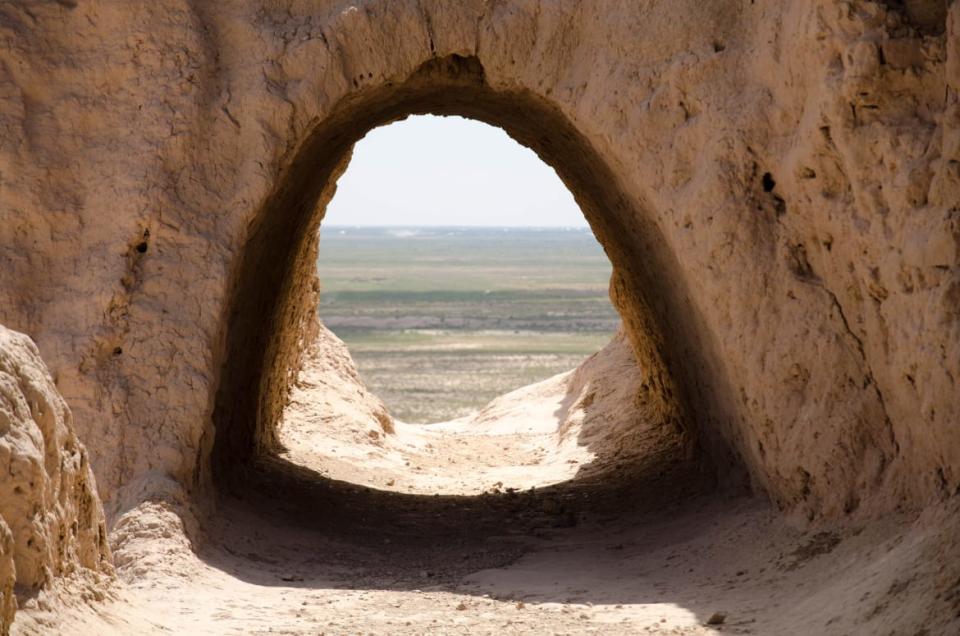
The Soviets pictured Ayaz Kala as part of a ring of border fortresses built to maintain control of the water. It sits on the edge of the oasis, the furthest north of the kalas. The Western archaeologists posit that it’s the sort of place that would have only been inhabited when the shifting waters allowed. All agree that beyond this point ancient people could not stay in place long. Beyond the oasis, movement meant survival and stillness meant death. This is where, long ago, a settled agrarian civilization would have reached its limit, where otherwise uncertain farmers would have turned into unstoppable wanderers, feudal lords into mobile aristocrats, and the social contract into a network of vagabond alliances. Past this place was nomad country, undeniably.
Shamil Amirov was born, raised, and trained as an archaeologist in Nukus, 80 miles northwest of Ayaz Kala. He moved to Russia three years ago, but when I called him in March, he was stuck back in Nukus. He’d been visiting family when Uzbekistan went into COVID-19 lockdown, so he was unable to leave the country. “This year there will be a catastrophe in tourism, not only in Uzbekistan,” he says. “In the middle of this epidemic, tourism is at a minimum. No one’s going anywhere. This will probably go on for another three months.” But the tourists will come back eventually, and he’s afraid of what they’ll find. The Ministry of Culture has been making major changes at some of the kalas. Amirov says that he is, in part, to blame for the aberrations they’ve produced.
In 2015, the upper chamber of Uzbekistan’s parliament held a special session in Nukus to puzzle out the preservation of the region’s culture and heritage. Amirov was asked to make a quick statement, detailing the problems from an archaeological point of view. He spoke for four minutes, maybe less. The main problem, he said, was salinity. There’s not enough water in the Amu Darya to let it seep lower than 5 feet into the soil of Uzbekistan’s fields. Otherwise, the fields would dry too quickly. But when water is kept at that level, salt migrates to the surface. In summer in this part of Uzbekistan, you see fields that look like they’re covered in snow. That’s all salt. If you walk around in it for seven weeks, it will eat your boots. Monuments like Ayaz Kala are relatively safe on their hills, but those that lie in the plains, like Pil Kala and Kyzyl Kala, are relentlessly belted and eroded by the corrosive element. Salt crystallizes on their walls, eats up a millimeter, and is blown away by the wind. More salt crystallizes, chews up more history, and flies on. “Slowly,” Amirov says, “the walls fall down.”
He read his statement and, a few days later, set off on an expedition. On the Ustyurt plateau, he got a call from an acquaintance at the Ministry of Culture in Tashkent. The man said his statement had made an impression. The government had allocated a prodigious sum for the restoration of Kyzyl Kala and Pil Kala. “But I hadn’t said anything about allocating money,” says Amirov. He’s not sure how one thing led to another, but soon the Ministry of Culture began building fresh walls over ancient ones.
“Made an impression,” he says. “Well, it made the wrong impression. I must have said something wrong. Now they’ve ruined Pil Kala and Kyzyl Kala.” Baker Brite, the Purdue University archeologist, is more circumspect in her comments. “Pil Kala is the one that I recently saw where they’re actively digging around the site to rebuild the walls,” she says, “which is problematic.”
But Amirov doesn’t hold back. “The people doing these restorations are incompetents,” he says. “There’s absolutely no historical authenticity in their work. It’s impossible to start doing restorations on a monument that’s not fully excavated. You have to dig everything up, document everything. How can you restore something if you don’t know what it looked like?” But even the most informed architectural solutions wouldn’t be enough. The changes, he believes, have to be much wider-reaching. “We need to find a way for agriculture to flourish and monuments to survive. Moving from cotton production to things that take less water, like vineyards and orchards, would take billions of dollars. It’s not the sort of thing that can be accomplished in a year. People would have to learn to live a new lifestyle. They’re working the same ways their fathers did. They don’t know any other way.”
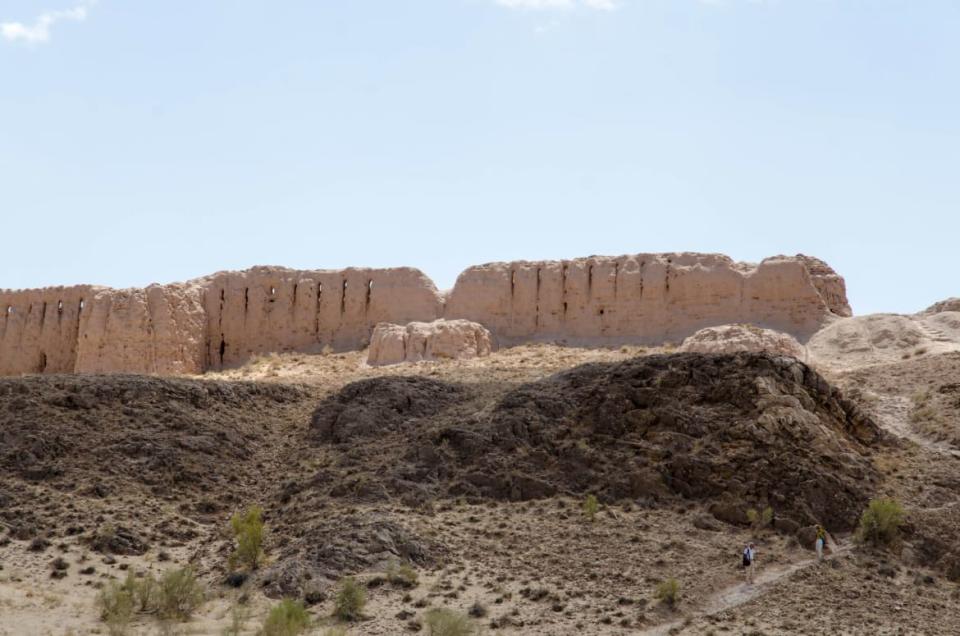
So they build walls, impressive because they’re large, disappointing because they’re new. “They mark it as restored and don’t give it another thought,” Amirov says. “There have been massive innovations in archaeology in the last 15 years, laser scans, drone surveys, but it is no longer possible to examine Kyzyl Kala. I can’t do anything there. I can’t understand how the Khorezmians constructed the walls because new walls have been built over them. The Ministry of Culture has spent millions on these walls and I’d be prosecuted if I destroyed them. But if they don’t stop this, they’ll ruin all the monuments, and the tourists will stop coming.” When our shared taxi drove on from Ayaz Kala to Kyzyl Kala, we were disappointed. The walls were fresh and disturbing. The sense of unalloyed history had been lost. Officials at the Uzbekistan Ministry of Culture and the National Tourism Commission did not respond to repeated requests for comment.
Ayaz Kala has been spared these indignities so far. In 2006, a UNESCO-sponsored project redirected water drainage paths on the mountaintop fortress and reinforced unstable portions. ”These are small interventions,” says Sanjarbek Allayarov, a programme officer in UNESCO’s Tashkent office, “but very practical.” Amirov says they did the right thing, though they used mud bricks of a size that would only have been used in a later period. “Maybe they didn’t have a mold for the ancient format,” he says. And while other kalas were used as dumps and burial grounds over the centuries, these fortresses seem to have been too remote for such utilitarian embarrassments.
That remoteness and inaccessibility might be Ayaz Kala’s salvation. The last people trying to live in a settlement here left in the 7th century. There are signs of brief human habitation in the 13th century in one corner of the high fortress, perhaps a lookout post, but these people, too, did not stay long. The fortresses’ most common state has been desolation. It’s in those lonely moments that Ayaz Kala has been at its most mysterious. Michelle Negus Cleary, an Australian archaeologist who first came to study these fortresses in 2001, remembers seeing a camel herder several times at Ayaz Kala. He brought his camels up the mountain, into the central clearing of the fortress, just as she believes the Khorezmians would have done.
The herders that frequent these ancient fortresses feel like they’ve been coming here forever, whether the fortresses were abandoned or occupied. When civilization recedes, again, and the tourists and archaeologists, the Uzbeks and Russians, are as long gone as the Khorezmians are today, perhaps the camel herder will cross his vast untamable domain, once more, and return to his lonely mountain keep. And when a new empire rises, they too may rediscover these places the nomadic herders have always known.
Get our top stories in your inbox every day. Sign up now!
Daily Beast Membership: Beast Inside goes deeper on the stories that matter to you. Learn more.

